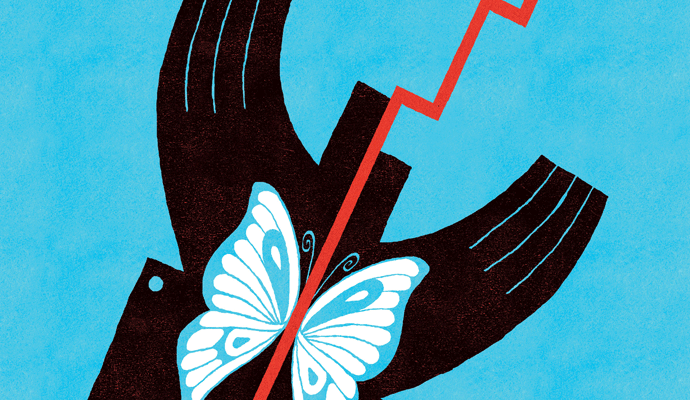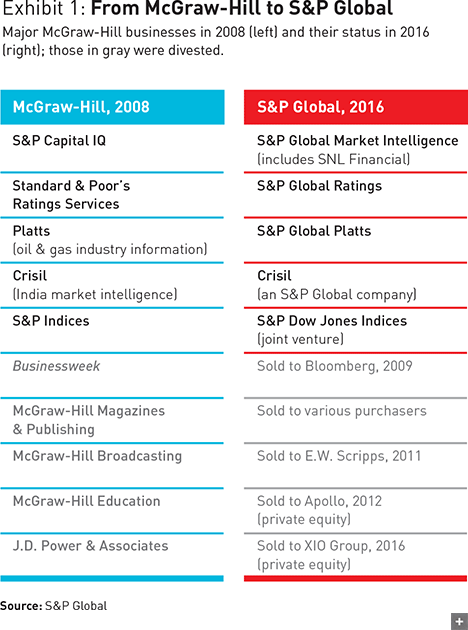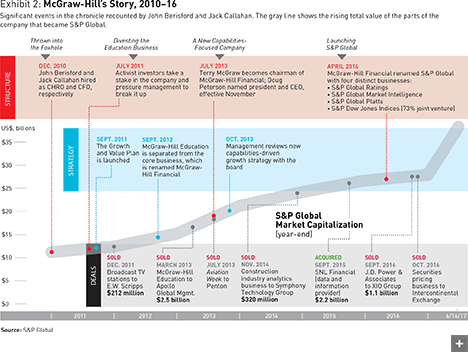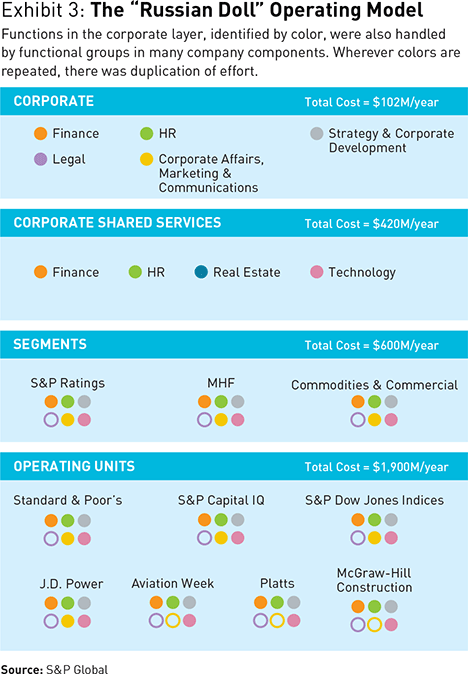Finance and HR: The Executive Partnership That Transformed a Company
Six years ago, two executives new to their jobs led the strategic transition that remade McGraw-Hill into S&P Global.
The most underused leverage in a company’s executive suite may be the relationship between its chief financial officer (CFO) and its chief human resources officer (CHRO). In most companies, these two leadership roles are often at odds as they pursue their functional agendas; it feels counterintuitive to prioritize both profits and people. But when the collaboration works — when the CFO and CHRO align their perspectives in service of the company and its shareholders — this unlikely alliance becomes a powerful engine of transformation and growth.
The reason is simple. Between them, the CFO and CHRO control the major sources of capital available to a company: financial, human, and often information technology. They have the ability and insight needed to assemble, analyze, and address the bare facts — how the company executes its strategy, what it spends, and what results ensue. By skillfully deploying the capital resources they wield, they can push a company to make and implement the tough decisions necessary to survive and prosper. Together, they can turn a company around.
One such collaboration took place at McGraw-Hill Companies starting in 2011, when John Berisford and Jack Callahan reported for work at the company’s New York headquarters. At the time, McGraw-Hill was an underperforming information conglomerate, with a variety of separately branded offerings. Some, like Standard & Poor’s, Capital IQ, and Platts (which covered the commodities markets) provided financial and industry information, and were moving rapidly toward an emphasis on customized offerings and analytics. There was a major education division, known for its textbooks and considered a pioneer in software and services. These two groups of information enterprises were attuned to different audiences (investors and business professionals on one hand, and educators and students on the other), and had different approaches to innovation and distribution. If McGraw-Hill wanted to continue to succeed with both divisions, it would necessarily mean taking ever more divergent strategic paths, making it harder and harder to remain coherent. Anyone looking ahead could see that massive structural and cultural changes were needed.
Because of their close working relationship, Berisford and Callahan would play critical roles in leading this successful transformation, overcoming what in many companies would have been a daunting obstacle: their status as relative outsiders. Each had recently been hired to fill vacated positions on the executive team, Berisford as CHRO and Callahan as CFO. As it happened, they had both previously worked at PepsiCo, though they hadn’t known each other there. Berisford joined McGraw-Hill directly from PepsiCo after 22 years; Callahan joined following a stint at Dean Foods after having spent a decade at PepsiCo. During the next six years, their partnership helped McGraw-Hill realize more than US$23 billion in value, as the company dramatically reduced costs, divested its education business, and relaunched itself as a growth-oriented operating company called S&P Global, with distinctive core capabilities in financial information and analytics. McGraw-Hill had been a diversified company held together by a perspective that accepted many kinds of information businesses under one roof. The new company had a much more focused value proposition: “essential intelligence to the capital and commodities markets” (see Exhibit 1).
Berisford and Callahan held their roles at S&P Global as CHRO and CFO, respectively, through 2016. Here is the story, as told in early 2017, of their company’s transformation — and the impact that two functional leaders can have when they put optimizing shareholder value at the top of their to-do list.
—Vinay Couto and Gary Neilson, Strategy&
Accidental Allies
Jack Callahan (CFO): Even if the CFO and the head of HR really like each other and get along, they often aren’t in the same room when decisions get made. The CEO confers with the head of HR for a while. Then, that person exits the room, and the CFO walks in.
John Berisford (CHRO): The stuff the CFO does is supposed to be different from the stuff the head of HR does. In the middle is the business. Well, the business brought us together. Our dialogue was always about the search for value and what we could do to uncover it. We tended to see issues through the same lens. Sometimes Jack would wander into my office and say, “I found something that I don’t like, but it’s in your space. Can you figure that out?” Other times, I’d go to him and say, “Look. I’m diving into the bonus pools, and I found something that doesn’t make sense. You might want to get your team to crank away at that.”
Callahan: I’ve dealt with a lot of HR folks in the past whose goal is making people happy. John was always focused on: Is the business operating well? He was always a businessperson — strategy oriented, shareholder focused. By the same token, I’m not an accountant.
Berisford: To most CFOs, the HR department is a cost center…something to cut. But Jack wasn’t just counting dollars. He understood the importance of getting the social issues and talent equation right. He was willing to make smart investments in some spots, while reducing costs in others.
Thrown into the Foxhole
Callahan: Because both John and I were new to McGraw-Hill, we found ourselves sorting the place out together, and John was masterful at walking the halls. Chairman and CEO Terry McGraw gave us a strong operational hand in running our functions, which forced us to work together as peers at an accelerated cadence.
Berisford: That said, while we arrived at the same time, our pairing was a bit more accidental than purposeful. Both the board and Terry McGraw understood that the company had reached a moment in time when new leadership was required to navigate a big transformation. And they had the courage to appoint leaders from the outside who could take on that kind of dramatic change.
The mandate became clear quickly. The stock had taken a hit after the [global] financial crisis. The company had sold Businessweek, but that was not enough. It did not get to the core of the problem [of an overly diverse company with businesses that did not fit its capabilities]. The shareholder voice was loud, and the board was very attuned to it.
Callahan: When I first walked in the door, I did not fully appreciate the level of shareholder discontent. I saw this company that had been around 125-plus years, weathered the financial crisis, built a broad portfolio, and become an everyday name. I thought we had a little time to sort the place out.
“The hardest thing in the world to do as a leader is dismantle the organization that you’ve spent your life building.”
But the pressure grew really fast. During the earnings release in the first quarter of 2011, which happened within seven or eight weeks of my joining the company, we had a question from one of the sell-side analysts that was sort of eerie in retrospect. He had been following the stock forever and a day, and he asked, “Why don’t you consider selling Education?” He meant the entire education division. There was stunned silence in the room. That was the first inkling that we were going to have to make some major changes.
Berisford: I remember talking to Jack on the phone the first day I got here and asking him, “Do these assets belong together?” He said, “Doubtful, but I don’t really know yet.”
The tricky part was navigating the various vested constituents. [The idea of breaking up the company] naturally provoked anxiety among some legacy leaders and large tranches of employees. Both Jack and I recognized the strain that it put on the existing management team. Many of them had been here for decades. The hardest thing in the world to do as a leader is dismantle the organization that you’ve spent your life building.
It was like being thrown into a foxhole together. We started assembling some facts, doing some analysis, just so we could begin to understand what we were trying to manage, and to build some conviction about what we needed to do and the path forward. We realized that the company would need to form a new leadership team.
Callahan: It was happening so fast. We immediately went to work evaluating the portfolio, cost structure, and capital allocation. There was a need to accelerate those efforts when we found out that activist investors Jana Partners and the Ontario Teachers’ Pension Plan were accumulating our stock with the likely intent to influence management. That provoked us to consider options. We put together a one-page assessment of McGraw-Hill’s portfolio, identifying where we could take out some costs and return money to the shareholders. To show we were serious, we announced we were going to sell McGraw-Hill’s TV stations. That was the first little step forward. The view from Wall Street was, “Boy, that only took about 30 years.”
In fact, we knew that wasn’t enough and had already scheduled a board meeting in London in June 2011 to consider the future of the education business within the portfolio. We had the entire education leadership team there, about 14 people, but the discussion was not very compelling. The next day, we had an investment banker come in to talk through our options. In the end, after an extensive board discussion, the verdict was clear — we were going to divest. We had the summer to do it. John and I had been in our jobs for only six months. Now we were two members of a group of only 10 people working on this secret project.
The outside world didn’t learn about it until August 1, 2011, when Jana Partners went public. They disclosed their position in the company to the SEC and published a white paper outlining what they felt the company needed to do. Their paper was pretty threatening; it suggested breaking McGraw-Hill up into not just two, but four pieces: education, media, market indices (Standard & Poor’s and Dow Jones), and the core financial information and analytics business.
In September, we came back to the board with the plan they had asked for [breaking into two pieces], which we called the Growth and Value Plan. We announced our intention to separate McGraw-Hill Education from the rest of the business, McGraw-Hill Financial, on September 12, 2011. The plan also included a cost reduction program and an intent to step up our return of capital to shareholders.
Once we made the public announcement, we had to involve hundreds of people to really do the work. We started to produce big, thick decks laying out what it was going to take to streamline and separate McGraw-Hill Education, while also recruiting a new CEO to run it. This was the beginning of a three-part story: the transformation of McGraw-Hill into S&P Global [see Exhibit 2].
Divesting the Education Business
Berisford: The next 18 months were all about setting up the transformation and getting costs out of the portfolio. This first part of the story culminated in the sale of the education business to the private equity firm Apollo Global Management for $2.5 billion in March 2013.
By this point, Jack and I were having dinner at least once a month. We’d sit down and ask, “What have we learned? Where are we making progress? Where are we not?” Ours was a very iterative process. We’d collect information, but we needed time to actually make sense of it, because on any given day, it could be overwhelming. You couldn’t connect the dots. It was often like a treasure hunt. I’d learn stuff. He’d learn stuff. We’d gather intelligence about how the business was actually running under the surface. And then we’d talk it through to uncover the truth.
Callahan: One of the huge challenges in a divestiture — particularly one under pressure from activist investors — is to separate and stand up a new company, taking costs out at the same time. Many companies defer dealing with stranded costs until later, but we didn’t take that view. We said, “We’re going to take out costs as we separate.” John and I spent many a long night working through these issues.
Berisford: I remember the analysis showing the prospect of shedding a third of our revenue and not getting at those embedded costs. I remember the value that would have been destroyed in the existing businesses.
Jack and I knew that if we didn’t cut costs while we had the momentum, it wouldn’t get done. You miss the window. As it was, we didn’t have to push too hard. We were able to chase out $50 million in stranded costs as we separated the business.
Callahan: This was particularly important on the education side. To sell or spin it off, we had to make it economically attractive. We knew from all the benchmarking we had done around shared-cost functions that we had pretty high costs. That created an opportunity to generate significant savings, but we had to reset the whole cost base.
Berisford: You would expect a conglomerate to have a light cost structure. But we had had so much internal infrastructure just trying to connect [all the parts of our company]. Every dollar we spent connecting the rating agency to the education business was a value-destroying dollar. For example, we did a lot of leadership development, but by making it applicable to all our disparate businesses, it had been diluted to the point where it wasn’t effective.
There was a real pot of gold here if we could release these savings, but even if they had been less significant, we still would have gone after them. Once costs get stranded, they’re hard to root out, and they destroy value.
Callahan: We shut down a shared-service center we had maintained in southern New Jersey. When that had been established back in the 1980s, it was leading-edge in pulling together shared administrative functions across HR and finance. But it had not been kept current. In 2011, it was a sprawling complex that was not run with a productivity mind-set. Costs were not transparent, so they couldn’t be easily divided between McGraw-Hill Education and McGraw-Hill Financial.
Berisford: We had redundant and shadow functions across the McGraw-Hill businesses. We called it the “Russian doll syndrome.” There was one big overarching layer: corporate costs. Then there were segment costs, subsegment costs, product costs, and so on. When you counted it all up, between the CEO and the product team, you might find seven, eight, or nine layers of management structure. It was conglomerates inside conglomerates [see Exhibit 3].
Callahan: This was an easy thing for us to get excited about. I liked the cost savings, and John liked the cleaner work structure, so fixing this became an area of mutual interest. We decided early on to outsource certain activities of both companies’ finance, HR, and IT.
Berisford: The combined back-office infrastructure had become so complex and intertwined that to set up the education business with its own back office would have stranded too much cost in the form of shared-services agreements and the like. The debate to do this was almost exclusively between Jack and me.
Callahan: That’s right — it was seen as our world. Admittedly, not everything went perfectly. Some of the choices we made, we ultimately had to reconsider and fix later. But our objective had been $100 million in annual savings, and we well exceeded it, generating $175 million.
Berisford: To position the education business for continuing success, we had to do more than cut costs. We had to put in place a credible leadership team to run it. Early on, the bankers told us, “You guys won’t get the maximum value out of the education business, because the world knows that you’re at the mercy of a few strategic buyers. [The textbook purchasers from key geographies tended to dominate the industry.] You won’t be given the option of an IPO unless you have a public company management team.” This drove us to take that extra step and recruit a new CEO. It was another one of these shareholder value–driven decisions, which frankly some management teams would not have taken on.
We had to find a CEO with the credibility of someone who could run a public company, but who wasn’t afraid of being bought by a private equity firm and possibly fired. There weren’t a lot of those candidates. I probably interviewed 25 people for the job, and I could tell in the first 15 minutes if they were up for the challenge.
Callahan: This was a rough, roller-coaster moment, where the teaming between CFO and CHRO was critical. At these moments of momentous change, it’s not the time to get penny wise and pound foolish.
Berisford: Because Jack and I together “owned” the human and financial capital levers, we could engineer compelling offers, not only to those we were looking to hire, but to those we were ultimately going to let go.
Callahan: I had a great deal of trepidation about our organizational readiness to execute because we both had come in the door being told, “There is the McGraw-Hill way, and we take our time.” In retrospect, kudos to how fast they did execute. There were some nail-biting moments, certainly. But overall we were happy with the way the teams stepped up. People performed better [under the new structures] than they had before, and better than our expectations. Even people who left the organization stepped up in ways I don’t think anyone would have imagined.
A New Capabilities-Focused Company
Berisford: Part 2 of the transformation was all about setting up a new company, McGraw-Hill Financial. This would take two years. Our focus was on making sure the transformation [described above] paid off, getting the management team right, and charting a more growth-oriented strategy around core capabilities such as financial credit analysis and data analytics.
Callahan: This phase started in July 2013, when Doug Peterson was publicly announced as the next CEO. John and I started to meet regularly with Doug, talking about what we were going to say to the board about the strategy of the company. By the time Doug officially took the reins on November 1, 2013, he could move forward purposefully.
Berisford: Doug had come on board as president of S&P Ratings [the former Standard & Poor’s business] in August of 2011 and was the first really important business leader to join after Jack and I got here. He was the cornerstone of the future management team.
Callahan: During the first stage, Doug had not been very intimately involved in the mechanics of the transformation itself. His role had been to provide a steady hand and a sense of continuity to our largest, most profitable business. Throughout that period of disruptive change, Doug and S&P Ratings gave us very, very good business results, which served to calm shareholders and employees. While we were transforming the company, we also needed to make money every quarter. Doug’s was a very steady hand on the switch throughout that period.
Once he became CEO, we moved into part 2: moving from a portfolio company to an operating company. Doug was engaged and incredibly supportive as we switched from divestiture to acquisition mode. He pushed for rapid and rigorous review of various larger acquisitions that made sense for our newly focused portfolio. Doug also moved quickly to resolve a number of S&P Ratings–related lawsuits, most notably with the U.S. Department of Justice — eliminating this uncertainty, and allowing us to use the balance sheet more assertively in growing the business.
Berisford: You can imagine, as a brand-new CEO, he was less interested in the rearview mirror. He became the focal point of growth, while Jack and I were still cleaning up the remnants of part 1 and trying to find the capacity to move into part 3.
Launching S&P Global
Callahan: The third chapter of the transformation opened with the acquisition of SNL Financial, a major financial data and information provider headquartered in Charlottesville, Va. We announced that deal in July 2015 — it was an obvious and compelling move from where we sat. But the shareholders felt quite differently. They felt we overpaid for the asset and ripped me apart, worse than Jana Partners had done four years before. A year later, they would love what we had done, and our stock price would be up to $120.
Berisford: By this point, we had money to spend and were establishing a growth agenda. Jack’s M&A team was looking at targets. We settled on SNL, and Doug dispatched Jack and me to begin the dialogue. This accidental partnership between the CFO and head of HR that had started in a foxhole in 2011 was now charting the company’s growth path. We had demonstrated that the power of this relationship was significant and meaningful, so it seemed only natural as we started the final chapter that we were tapped to lead the work.
Jack’s goal in the early phase was to run the valuation, and my job was to get to know the management team and sort out the social issues. Typically — if you look at this through a traditional lens — the acquirer takes the view, “We’re paying the check. Our management team wins. Their management team loses.” That’s not how it worked here. Together, Jack and I quickly arrived at the conclusion that we couldn’t get enough value out of this acquisition if we just tucked it in.
Callahan: The biggest constraint our company had at the time was management talent. We hoped to use the acquisition to add to our management depth.
Berisford: Jack took the board through the math in June 2015 in London. I was dispatched directly from that meeting to Charlottesville to determine how good this operation was and whether we could get their management to do this deal.
Jack’s role was to figure out the past value. My role was to figure out how to assemble a management team and deal with social issues, so we could realize and multiply that value. Along the way, we turned convention on its head. The board suggested that we offer earn-outs [deferred bonuses based on the performance of the acquired business] for SNL’s partners to keep them on board after the acquisition. We pushed back, arguing, “They built this business over 20 years. Why would they want to be retained with their own money?”
Meanwhile, we knew we needed the SNL top talent to stay, and we had already been thinking about incentivizing them to buy stock. By the time the board started asking questions like “Would these guys stay? Do you have them locked up?” Jack could answer, “We don’t have retention agreements. They actually bought a sizable amount of our stock.” This is a better way to get an acquiree to invest some skin in the game moving forward, and it worked. In the first full year, the organic profit of the combined units increased 68 percent. There was an enormous synergy boost.
Callahan: Often when you do synergy analysis, you expect [synergy-based cost reductions] to come from the target. We thought much more about the synergies that were going to come from our side. We felt we were the operation with higher costs and more management gaps. So we assembled a “best of” team from our side and their side to run the collective set of assets better, with the president coming from SNL. If you track back where the [cost savings] came from, as much came from our legacy business as from the acquisition.
The culmination was the relaunch and rebranding of the company as S&P Global in April of 2016, underscoring the fact that our flagship products — the ratings agency, stock market indices, and financial benchmarks and analytics business — were more identified with the name Standard and Poor’s [than with McGraw-Hill].
All too often, the CFO is primarily focused on what to do while the CHRO is focused on how to implement or who to lead. John and I continuously worked on all these questions in a highly collaborative way, with each day providing more insight on the best path forward.
Berisford: The main question a CEO should ask an HR leader — or a CFO, for that matter — is “Do we have the horses [capabilities] and the human capital to execute the strategy?” And, by the way, very few CEOs ask their CFO and CHRO that question. But Jack and I always saw our job as just that: figuring out whether we had the leadership, the horses, and the human capital to achieve the company’s strategic objectives. I think we were effective because we immediately saw the power in our combining forces as the owners of human and financial capital. We realized the compelling synergies of that combination. One plus one didn’t equal two. It equaled something much more than that.
So if I were to offer advice to a CEO looking to hire executives into the CHRO or CFO role, I would urge him or her to recruit individuals with the objectivity and business broad-mindedness to put shareholder value above all else. And then throw them into a foxhole together.
Reprint No. 17309
Author profiles:
- John Berisford was the chief human resources officer at McGraw-Hill (later S&P Global) from 2011 through 2016. He is now president of S&P Global Ratings, the company’s flagship business.
- Jack Callahan was the chief financial officer at McGraw-Hill (later S&P Global) from late 2010 through 2016. He is now the senior vice president for operations at Yale University.
- Also contributing to this article were Vinay Couto,PwC US principal and leader of the Fit for Growth platform for Strategy&, PwC’s strategy consulting group, and Gary Neilson, PwC US principal and operating model specialist for Strategy&.







